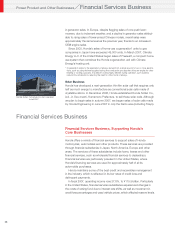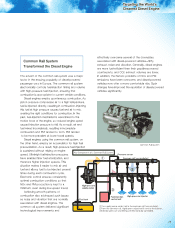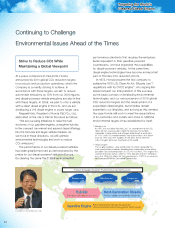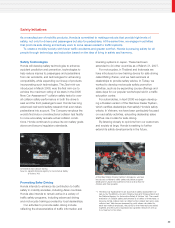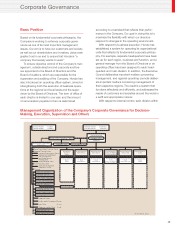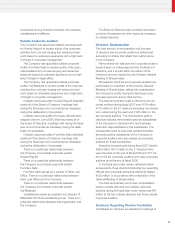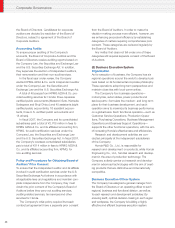Honda 2007 Annual Report Download - page 38
Download and view the complete annual report
Please find page 38 of the 2007 Honda annual report below. You can navigate through the pages in the report by either clicking on the pages listed below, or by using the keyword search tool below to find specific information within the annual report.
36
Working to Achieve 2010 Global CO2
Reduction Targets for Products and
Production Activities
Honda’s goal is to manufacture products that produce
the lowest level of CO2 emissions at plants that also
emit the least CO2. We have established targets to
reduce CO2 emissions from our products and
production activities worldwide.
CO
2
reduction target for products 10% reduction
(g/km)
20% reduction
(per unit produced)
CO2 reduction target for production activities
10% reduction
(g/km)
10% reduction
(per unit produced)
10% reduction
(kg/hour of operation)
20% reduction
(per unit produced)
CO
2
reduction
for products:
Major
activities:
To meet its CO2 reduction targets for
(calendar year) 2010, Honda intends to
invest worldwide in technologies to
improve fuel efficiency and expand the
application of its programmed fuel
injection (FI) systems.
• Fuel injection: Install in the majority of
motorcycle models released worldwide
by the end of 2010
• Variable Cylinder Management system:
Improve fuel efficiency by 30% or more,
compared with the 2005 level.
Honda is implementing a variety of
technologies to improve fuel efficiency
and reduce CO2 emissions.
• Hybrid vehicles: Honda is developing a
dedicated hybrid vehicle to advance
global hybrid development. We plan to
introduce this hybrid vehicle in 2009.
• Diesel vehicles: Honda is developing a
new generation of clean diesel engines,
which we plan to install in vehicles for
the North American market within the
next two years.
• Gasoline vehicles: Honda plans to
further improve fuel efficiency through
advanced engine design.
• Fuel cell vehicles: In 2008, Honda plans
to begin limited sales in Japan and the
United States of a next-generation fuel
cell vehicle based on the FCX Concept.
Honda is committed to the effort to
achieve cleaner emissions and
improvement in fuel efficiency ahead
of the regulations of each country
and region.
• Next-generation general-purpose
engines: Improve fuel efficiency by
approximately 20% compared with
other conventional engines
• Compact household cogeneration
system: A reduction of approximately
30% in CO
2
emissions is expected.
Together with Climate Energy, LLC,
Honda began sales of this system in
March 2006.
CO
2
reduction
for production
activities:
<CO
2
reduction target for Motorcycles>
<CO
2
reduction target for Automobiles>
<CO
2
reduction target for Power Products>
<CO
2
reduction target for production activities>
For more than 90% of products sold worldwide, including Japan, North America, Europe, Thailand, India, China, Indonesia, Vietnam, Brazil, the Philippines, Malaysia
and Pakistan.
For more than 90% of products sold worldwide, including Japan, North America, Europe, Asia, the Pacific, China and Latin America.
Including all products sold worldwide except outboard.
In addition to Honda Motor Co., Ltd., all Honda manufacturing plants and major parts suppliers in Japan and worldwide are subject to this target. It includes almost
100% of Honda’s consolidated subsidiaries, affiliated companies, and manufacturing plants of major affiliated companies.
*1: We have already reduced emissions by 13.2%. compared to fiscal 2001. We will continue to strive to reduce CO
2
emissions further with the CO
2
reduction
target of 10% by 2010 unchanged.
*2: We have already achieved the target. However, we see production increasing in regions with a high CO
2
emissions coefficient. We will hold our CO
2
reduction target unchanged and will continue to strive to further reduce CO
2
emissions toward 2010.
*3: The basic unit of production for power products increased due to products that are higher-value-added as well as larger.
100
90
80
70
(%)
00 06
100
90.5 90
10 (target)
120
100
80
60
(%)
00 06 10 (target)
Progress of CO2 Reduction by Fiscal 2007 for Products and Production Activities
2010 CO2 Emissions Targets for Products and Production Activities Worldwide (compared to fiscal 2000)
100
80
104.4
100
90
80
70
(%)
00 06
100
94.0 90
10 (target)
100
90
80
70
(%)
00 06 10 (target)
100
80
100
90
80
70
60
(%)
00 06 10 (target)
70.7
100
90
100
90
80
70
(%)
00 06 10 (target)
86.8
100
90
93.1
Average CO
2
emission from Honda’s products worldwide
Average CO
2
emission from Honda’s manufacturing process per unit
Scope of Data Collection
13.2% reduction*
1
29.3% reduction*
2
4.4% reduction*
3
Motorcycles 6.0% reduction 6.9% reduction
9.5% reduction
Automobiles
Power Products
Motorcycles
Automobiles
Power Products
Motorcycles Automobiles
Power Products
Environment and Safety


